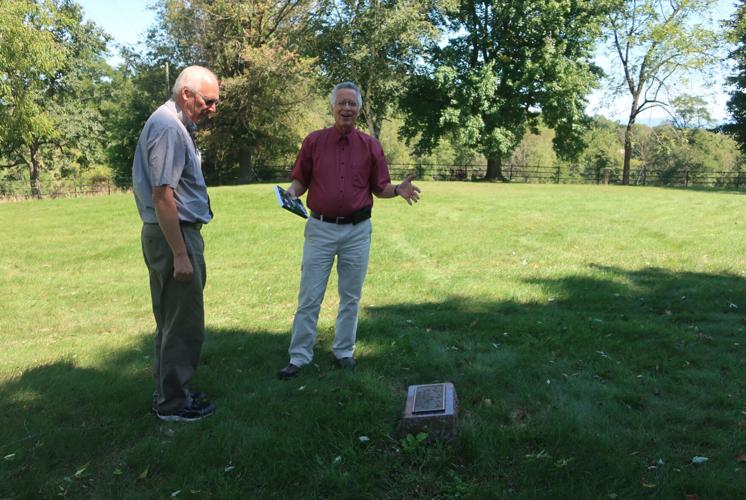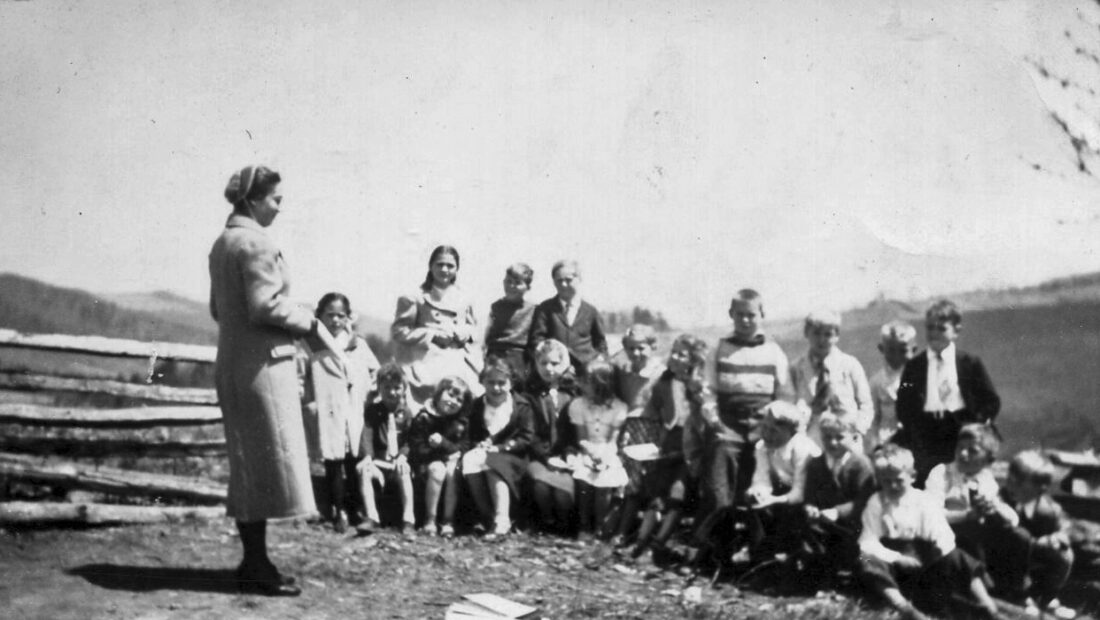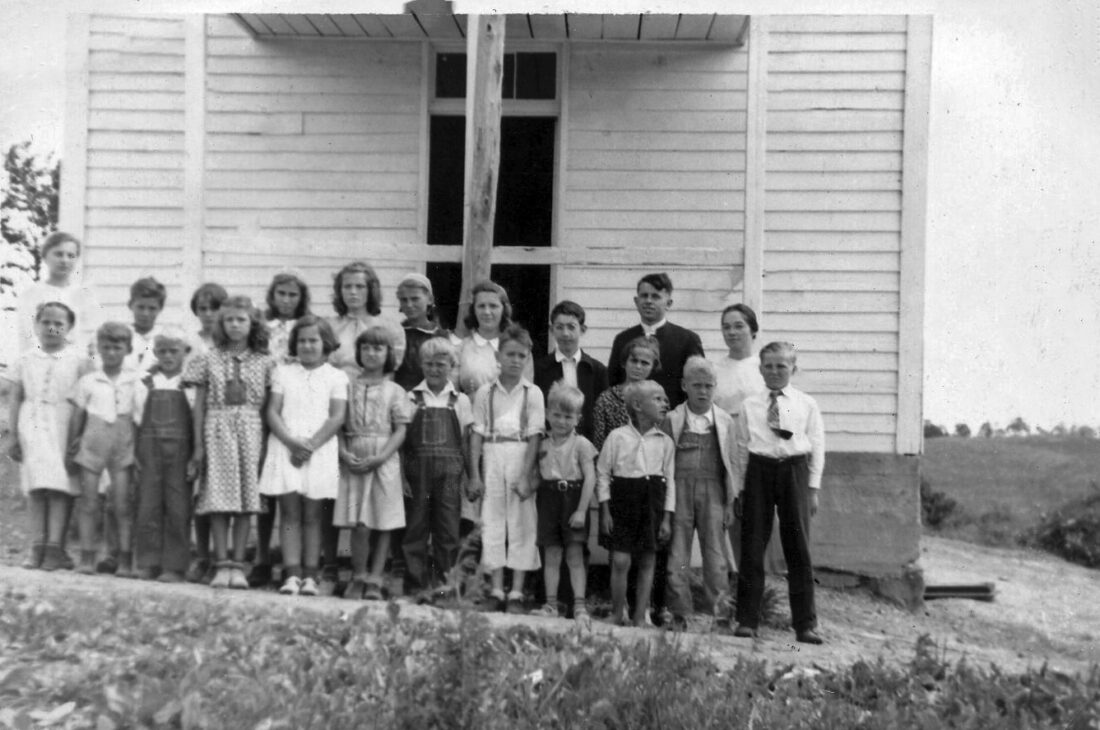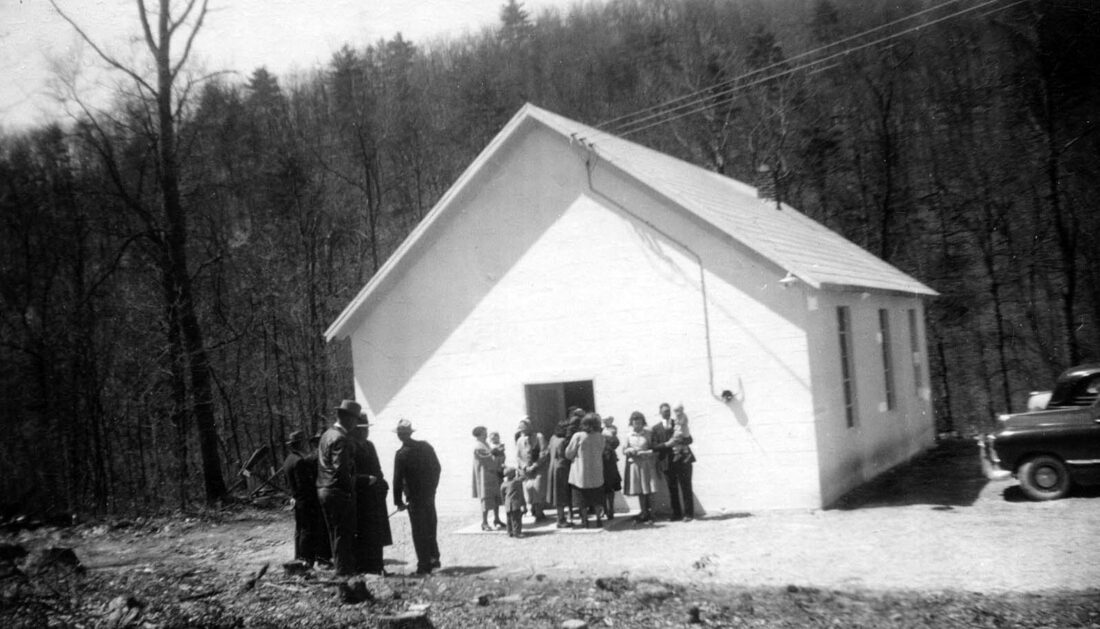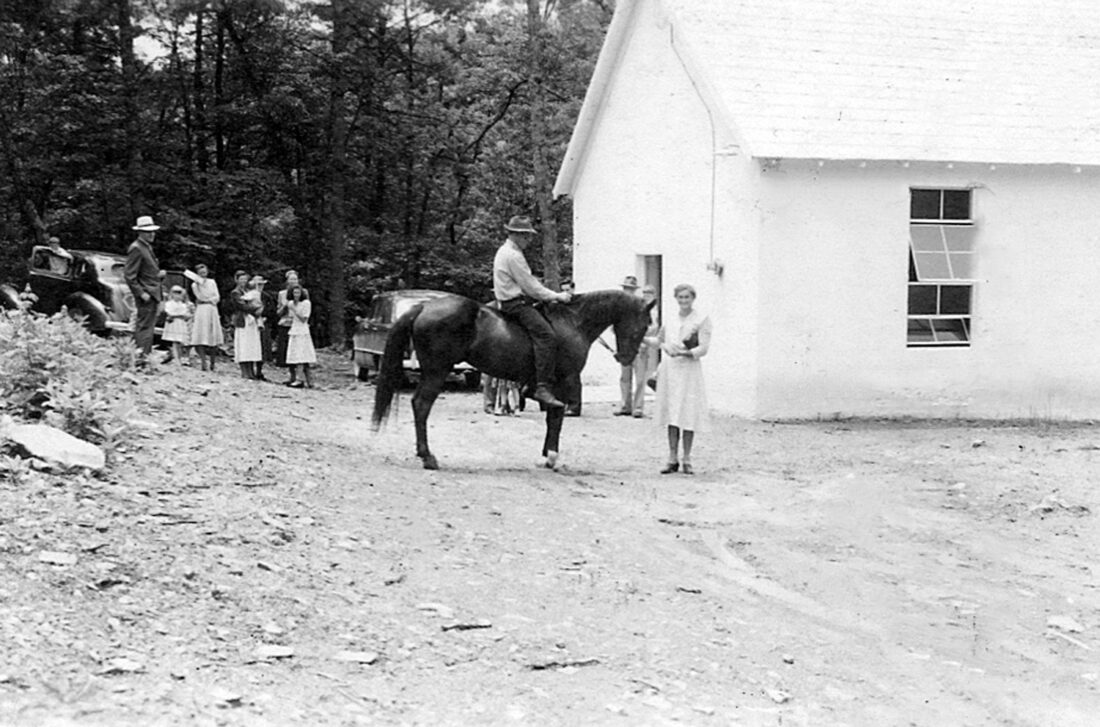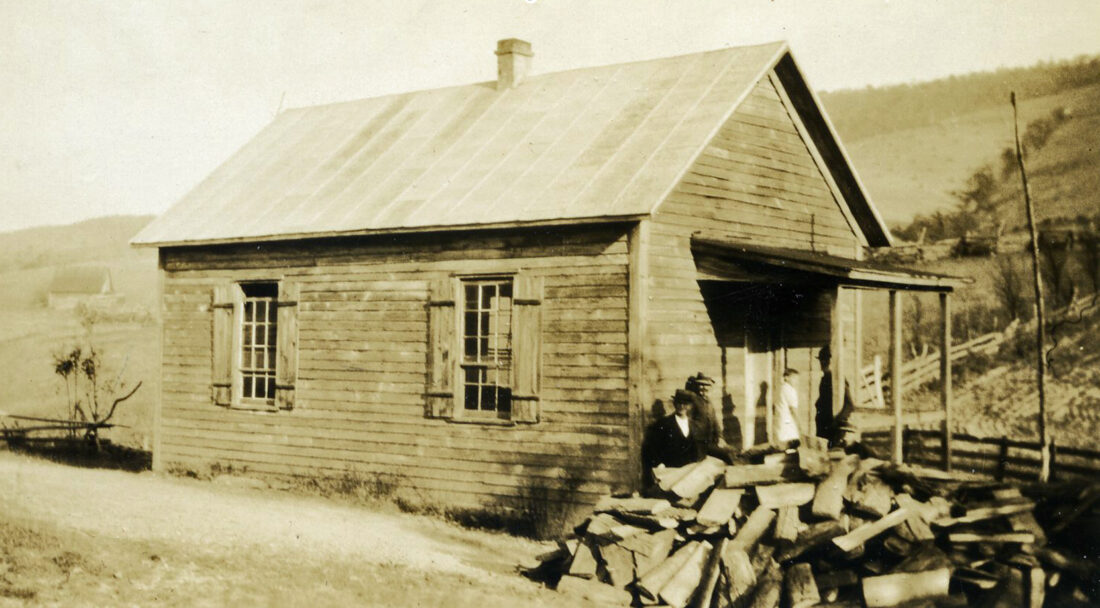An address given to Virginia Mennonite Conference, July 15, 2022, under the oaks at Trissels Mennonite Church, using Acts 2:1-4; 14-21; Video of the address.
The Holy Spirit empowers congregations for ministry, service, and witness. When the believers at Pentecost received the Spirit, they moved out from their Jerusalem home base. Spirit-empowered mission is my theme.
The Spirit has gifted this congregation for the past two hundred years with multiple gifts. All of our congregations have received Holy Spirit gifts. The four gifts I’ll mention are hospitality, generosity, itinerancy, and ministry.
Here’s an illustrative story. Two weeks ago, I drove about thirty miles north of here into Hardy County, West Virginia. Hidden back in the woods next to the Lost River State Park, I found the block building of the former Buckhorn Church, built by Trissels folks and others in the Northern District.
Northern District ministers began their itinerancy to the Buckhorn community in 1930, and held meetings in the local schoolhouse. During the ‘30s and ‘40s, young adults followed and taught Summer Bible School and Sunday school. In the 40s the Summer Bible School program thrived. Maude Geil, Robert Alger, and Linden Wenger were among those dozens of young adults who went to Buckhorn in ministry and taught. Men from the Buckhorn would come to Rockingham County and work on Mennonite farms during harvest season. They were shown hospitality.
When the folks at Buckhorn asked Northern District ministers if they could have their own meetinghouse, the ministers raised the money in the home base churches. Home base churches were generous with money and labor to build a cinder block structure in 1948.
All four gifts (hospitality, generosity, itinerancy, and ministry) came together in that Northern District outpost, a remote region in mountainous Hardy County. In the early 1970s, Buckhorn merged with Cove, Cullers Run, and Mt. Hermon to form Mathias Mennonite Church.
Hospitality (1): “The wind came from heaven and filled the whole house where they were sitting (Acts 2:2)”, probably while they were eating a meal. Did you know that the Mennonite Community Cookbook emerged out of the Trissels congregation? In 1950, Mary Emma Showalter Eby (1913-2003) completed her best-selling cookbook, published by Herald Press in 65 editions. Over 500,000 of the books have sold, making it the best-selling book of any EMC or EMU faculty member. Mary requested recipes, and she received several thousand, with some mailing their entire cookbook to her home in Broadway. She chose over 1100 recipes, including from a half dozen Trissels women and another half dozen from women in Hartville, Ohio. Mary Emma’s cookbook was a gift of hospitality to her church, her conference, her denomination, our dinner tables, and far beyond.
When the Mennonite General Conference met in Harrisonburg in August 1919, preliminary meetings took place at Zion and Trissels, with Bishop Lewis and Mattie Shank’s kitchen table being the hub of activities. Gospel Herald Editor Daniel Kauffman came to Broadway for those meetings. After almost every Mennonite family in the area helped host the 1000 visitors who came, and after the Virginians gave a surplus offering of $1000 for missions above expenses, Daniel Kauffman wrote that “When it comes to hospitality the Virginia brethren never do things by halves.” (GH April 8, 1920)
Seventy years ago, July 23-25, 1952, for the tenth time, Trissels hosted the annual Virginia Conference meetings. Moderator Truman H. Brunk Sr. welcomed newly ordained ministers Norman Derstine, Dan Smucker, and Myron Augsburger. At the end of the Conference, the delegates passed a resolution of thanks to the Northern District for the kind hospitality shown to the delegates.
Three years ago, on September 9, 2019, the Trissels Hospitality Committee, with Zola Showalter and LuAnn Bender, showed wonderful hospitality in a pre-covid world, serving a light meal to twenty-nine delegates and guests of the Northern District Council. Trissels did it again, offering up gracious southern hospitality.
The Spirit’s gift of hospitality flows out of a Christian commitment to serve the spiritual, physical, and economic needs of others. “Practice hospitality (Romans 12:13), and all of them were filled with the Holy Spirit”
Generosity (2) Laura and Steve Campbell just returned after ten years of missionary work with VMM in Montenegro. Trissels gave generously to their work, and two leaders from this congregation served on their Ministry Support Team. They worked in a city where only a few have seen the light of Christ. I’ve read articles about their work, attended a fundraiser or two, and taught Laura in world history, but only recently learned that Laura Moyers Campbell is an eighth-generation descendant of Daniel and Margaret Showalter (Margaret died 1816 and Daniel died 1822). The historical records I’ve seen show that Trissels has been a generous congregation, supporting both the Conference and Virginia Mennonite Missions. A co-chair of the VMM capital campaign attends this congregation.
Some of you knew Mary Brunk Moyers (1913-2008), an outstanding quilter. She was also a generous woman. For sixty years attending here, she made around a hundred quilts that she donated to the Virginia Relief Sale. In 1987, Mary’s four quilts brought $5000. In 1988, Mary’s “Jacobs’s Fan” brought an all-time high of $5000. Mary and the Trissels Sewing Circle, since 1920, have been generous with their skills and service work.
The Spirit’s gift of generosity at Trissels extends to neighbors near and far. “All the believers were together and had everything in common. They sold property and possessions to give to anyone who had need (Acts 2:44-45), and all of them were filled with the Holy Spirit”
Itinerancy (3): “The Holy Spirit said, ‘set apart Barnabus and Paul for the work to which I have called them’…and the believers sent them off. (Acts 13:2-3)” Similar to the first-century itinerancy of the apostles, a quickening, an awakening, a Spirit-inspired mission’s impulse moved among Virginia Mennonites after the Civil War. Leaders saddled up and rode into the western highlands. Spurred by a desire to preach the gospel, Mennonite ministers rode to remote mountain regions and preached in schoolhouses, union churches, and people’s homes. In some locations, like Buckhorn, the Northern District built meetinghouses for new churches.
Inspired partly by the wider Protestant mission’s movement, Northern District ministers traveled like itinerant apostles in the Book of Acts, going from one place to the next, preaching the good news of the gospel of Jesus Christ, because they believed in the good news of Jesus. And all of them were filled with the Holy Spirit.
Bishop Samuel Shank Sr. led the way in the Northern District and went into West Virginia even before the Civil War. He was followed by bishops John Geil, Abraham Shank, and Lewis Shank. Itinerant ministers rode thousands of miles on horseback and carriage, and then automobile. Their ranks include Samuel Shank Jr., George B. Showalter, Mark C. Showalter Sr., Perry E. Shank, Timothy Showalter, Joseph W. Geil, J. Hopkins Turner, and Samuel A. Shank.
John S. Coffman was a renowned Mennonite evangelist of the late 19th century. John Coffman grew up in the Virginia Conference. At age 26, in October 1876, he traveled with Northern District minister Samuel Shank Jr. on a three-day horseback riding jaunt to schoolhouses and churches north of Trissels. Coffman and Shank stayed in the homes of local people, and they preached wherever folks would listen to their messages. They went to Lost River, Baker, and Wardensville. Coffman’s journal is how we know details. It is hardly an overstatement to say that a Virginia man sparked the late nineteenth-century missions awakening in the Mennonite Church which came right down into this church.
About twenty years ago, Martha Shank Whissen (1914-2019) brought her father’s oil lantern along to church at Zion. Perry E. Shank, her father, served Trissels and the Northern District for over fifty years as a minister. At age 83 Perry attended the 1952 Conference here at Trissels. A farmer from Broadway with little education, Perry was ordained by lot. Perry rode horseback, carriage, and car into the mountains. Perry used an oil lantern on his buggy when driving at night. In the early twentieth century, Perry ministered in several dozen schoolhouses and churches of the Northern District. He believed in mission. He’d leave on Friday from his Broadway farm and come home late Sunday evening, with his lantern. J. Ward Shank tells of his father leaving after a Sunday evening service, having three flat tires on the way home, and arriving at 4 a.m. (HAB 54)
In the late 19th and early 20th centuries, Trissels and ND ministers launched an itinerant mission’s movement that inspired a host of young adults from this church, the Northern District, and the Virginia Conference. Twenty-two churches emerged in the highlands, like Buckhorn, and it was considered home mission, done without the support of a mission board.
Spirit-gifted itinerant bishops, ministers, and deacons went out with a desire to preach the gospel, minister to others, and build up the kingdom. “(Acts 16:9-10) Come over to Macedonia and help us, and so Paul and his itinerant companions got ready at once to preach the gospel…and they were all filled with the Holy Spirit.”
Ministry (4) The era of itinerancy from leaders prompted a quickening, an awakening, a movement of the Spirit among Virginia Mennonites, that lasts to this day. Four stories to illustrate. Mattie Shank traveled with her bishop husband for decades, assisting his work of visitation, counseling women, helping with communion, attending funerals, and providing coverings and bonnets. Though not ordained a deaconess, she operated like one. One of the largest early twentieth-century funerals at Trissels and Zion was of Mattie Shank, in 1934 when hundreds came to pay their respects.
Elizabeth A. Showalter (1907-1998) was one of the pioneers of the Summer Bible School program in the Northern District and the Mennonite Church. She followed her father, George B. Showalter, who had ridden hundreds of preaching itinerant circuits into West Virginia. Elizabeth taught Sunday School and developed Summer Bible School curriculum. Elizabeth said that in 1938 over half the 1050 Northern District Mennonites were folks in the highlands. Elizabeth knew of eleven Sunday schools in the district, needing 70-80 workers to staff the classes, with 25-70 students in each location. Elizabeth reported that to go from the home base in Broadway to each of the preaching appointments separately, one would travel 1500 miles. There’s a fun photo in the history book of Elizabeth taking twenty children in her car to Summer Bible School at Hebron, in Fulks Run. Summer Bible Schools began in the Northern District in 1932, and Elizabeth helped pioneer and energize the work. During the 1930s and 1940s, there was nothing like this anywhere in the Mennonite Church. Harry A. Brunk uses a page and a half of fine print to list all the youth. Elizabeth took her experience in the highlands to Scottdale and wrote Summer Bible School curriculum for the Mennonite Church. She edited Words of Cheer and was known as “Aunt Beth” to her readers. In 1961, she began “Books Abroad,” in the red barn, to furnish donated used books for institutions and persons overseas.
Helen Trumbo Shank (1925-2020) was among those dozens of youths in the 1940s from Trissels, Zion, and Lindale who volunteered their summers and traveled into the highlands to conduct summer Bible school. Helen remembered that during one summer in the early 1940s, maybe 17-18, she taught five Summer Bible School sessions of two weeks each. Business people in the district provided her a trailer or a tent while she lived away from home. The Mennonite community encouraged their young people in this local mission’s endeavor, and responsive young adults reveled in the mission impulse of their home base church communities. Helen remembered visiting mountain homes in the afternoons and evenings. At mealtime on one occasion, Helen recalls, with three teachers, “One got a spoon, one a fork, and one a knife.”
Amanda Showalter (1891-1980) often accompanied her husband Mark C. Showalter Sr. (1895-1978) to highland churches where they served as energetic and dynamic Mennonite mission developers. Married in 1919, Amanda and MC gave their best years to small congregations. Mark used his poultry industry business skills to help families earn an income and provide for their needs. MC first convinced a family to build a brooder house, then he supplied a wood-burning brooder stove, chicks, and feed. Fourteen weeks later he marketed the birds and paid the family.
For over twenty years Amanda and MC helped raise up Salem Mennonite Church, Hardy County, W. Va. Then in the early 1950s, Amanda and MC helped start the Stephens City Mennonite Church. Amanda and Mark were seldom seen on Sunday mornings at Trissels or Zion. Instead, they drove to mission stations to support small mountain churches. Oh, Amanda and MC offered itinerant ministers and Summer Bible School workers “gospel gas,” where all you had to do was stop at their farm, fill up your vehicle, and write down how many gallons you pumped.
My call is that God would spark a quickening, an awakening of Holy Spirit gifts for mission in our era. Mission is to the church as fire is to burning, 1963. Outreach the reason for the 1965 Educational wing. Four community families joined here in the 1960s. I’m calling for a home-based mission awakening, to neighbors and friends nearby, like when Nelson Swope began a Sunday morning ministry at Living Water Senior Care in Timberville, in 1990, and this congregation rallied to help. I raise this missional vision praying and believing that with Holy Spirit gifts like hospitality, generosity, itinerancy, and ministry, we can reenergize our churches to focus on mission once again. A focus on mission in the VMC strategic plan, the Conference mission statement, and now is the time to refocus and energize that Holy Spirit vision.
Our Master called us to “Go and make disciples of all nations, baptizing them in the name of the Father and of the Son and of the Holy Spirit, and teaching them to obey everything I have commanded you. And surely, I am with you always, to the very end of the age.”


